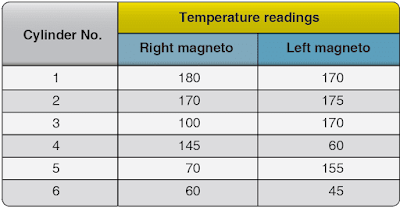Engine difficulties that can be analyzed by use of the cold cylinder indicator are [Figure 1]:
 |
| Figure 1. Cold cylinder indicator |
- Rough engine operation
- Excessive rpm drop during the ignition system check
- High manifold pressure for a given engine rpm during the ground check when the propeller is in the full lowpitch position
- Faulty mixture ratios caused by improper valve clearance
In preparation for the cold cylinder check, head the aircraft into the wind to minimize irregular cooling of the individual cylinders and to ensure even propeller loading during engine operation.
Operate the engine on its roughest magneto at a speed between 1,200 and 1,600 rpm until the cylinder head temperature reading is stabilized. If engine roughness is encountered at more than one speed, or if there is an indication that a cylinder ceases operating at idle or higher speeds, run the engine at each of these speeds, and perform a cold cylinder check to pick out all the dead or intermittently operating cylinders. When low power output or engine vibration is encountered at speeds above 1,600 rpm when operating with the ignition switch on both, run the engine at the speed where the difficulty is encountered until the cylinder head temperatures have stabilized.
When cylinder head temperatures have reached the stabilized values, stop the engine by moving the mixture control to the idle cutoff or full lean position. When the engine ceases firing, turn off both ignition and master switches. Record the cylinder head temperature reading registered on the flight deck gauge. As soon as the propeller has ceased rotating, apply the instrument to each cylinder head, and record the relative temperature of each cylinder. Start with number one and proceed in numerical order around the engine, as rapidly as possible. To obtain comparative temperature values, a firm contact must be made at the same relative location on each cylinder. Note any outstandingly low (cold) values. Compare the temperature readings to determine which cylinders are dead (cold cylinders) or are operating intermittently.
Difficulties that may cause a cylinder to be inoperative (dead) when isolated to one magneto, either the right or left positions, are:
- Defective spark plugs
- Incorrect valve clearances
- Leaking intake pipes
- Lack of compression
- Defective spark plug lead
- Defective fuel-injection nozzle
Repeat the cold cylinder test for the other magneto positions on the ignition switch, if necessary. Cooling the engine between tests is unnecessary. The airflow created by the propeller, and the cooling effect of the incoming fuel/air mixture is sufficient to cool any cylinders that are functioning on one test and not functioning on the next.
In interpreting the results of a cold cylinder check, remember that the temperatures are relative. A cylinder temperature taken alone means little, but when compared with the temperatures of other cylinders on the same engine, it provides valuable diagnostic information. The readings shown in Figure 2 illustrate this point. On this check, the cylinder head temperature gauge reading at the time the engine was shut down was 160 °C on both tests.
 |
| Figure 2. Readings taken during a cold cylinder check |
A review of these temperature readings reveals that, on the right magneto, cylinder number 3 runs cool and cylinders 5 and 6 run cold. This indicates that cylinder 3 is firing intermittently, and cylinders 5 and 6 are dead during engine operation on the plugs fired by the right magneto. Cylinders 4 and 6 are dead during operation on the plugs fired by the left magneto. Cylinder 6 is completely dead. An ignition system operational check would not disclose this dead cylinder, since the cylinder is inoperative on both right and left switch positions.
A dead cylinder can be detected during run-up, since an engine with a dead cylinder requires a higher than normal manifold pressure to produce any given rpm below the cut-in speed of the propeller governor. A dead cylinder could also be detected by comparing power input and power output with the aid of a torquemeter.
Defects within the ignition system that can cause a cylinder to go completely dead are:
- Both spark plugs inoperative
- Both ignition leads grounded, leaking, or open
- A combination of inoperative spark plugs and defective ignition leads
- Faulty fuel-injection nozzles, incorrect valve clearances, and other defects outside the ignition system
In interpreting the readings obtained on a cold cylinder check, the amount the engine cools during the check must be considered. To determine the extent to which this factor should be considered in evaluating the readings, re-check some of the first cylinders tested, and compare the final readings with those made at the start of the check. Another factor to be considered is the normal variation in temperature between cylinders and between rows. This variation results from those design features that affect the airflow past the cylinders.